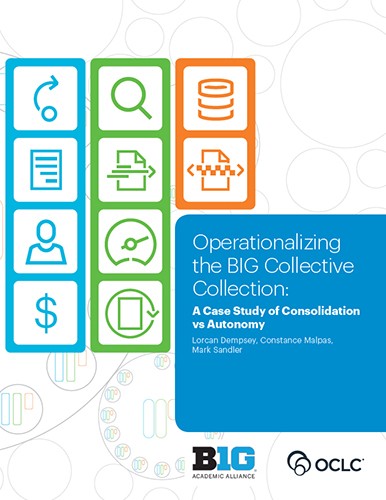Operationalizing the BIG Collective Collection: A Case Study of Consolidation vs Autonomy
By Lorcan Dempsey, Constance Malpas, and Mark Sandler
Prepared in collaboration with the Big Ten Academic Alliance (BTAA) Library Initiatives, this report presents a framework for operationalizing the BTAA collective collection—a collection managed collaboratively across a network of libraries—and is focused specifically on the ”purchased” or print collection.
The BTAA justifiably claims to be the premier academic collaboration in the US. Once described as “the world's greatest common market in education,” it leverages the combined research and teaching capacity of major research universities to scale innovation, impact, and economies across its 14 members. Libraries are a central part of the BTAA research, learning, and teaching endeavor. They collectively mobilize major expertise and resources. In fact, the BTAA collection represents more than a fifth of all titles in the North American print book collection. The BTAA libraries align with BTAA goals by collaborating at scale to increase both impact and efficiency.
The character of library spaces, services, and collections is evolving with changing learning and research behaviors. It is widely recognized that continued autonomous development of large standalone collections does not meet needs and is not efficient. A library cannot collect all that its members would like to see, and much of what it does collect does not get used. At the same time, library space is being configured around engagement rather than around collections, the long-term stewardship costs of print materials are being recognized, and the role of books in research and learning is changing. Libraries are re-evaluating traditional approaches to building, managing, and sharing collections, and are increasingly looking to do this cooperatively.
In this report, we define and explore key attributes of collective collections and present a series of recommendations designed to advance the BTAA libraries toward a more purposeful coordination of their collections. We describe four attributes of a more purposefully coordinated collective collection, that can be an example for any library collaboration: explicit commitments, efficient network fulfilment, optimally distributed collection, and systemwide awareness. And additionally outline three broad areas where coordination is required to deliver the collective collection: Enterprise, Applications, and Collections.
The approach to coordination we recommend is broadly applicable in other consortium settings as well, providing lessons and recommendations that any group of libraries can benefit from.
Suggested citation:
Dempsey, Lorcan, Constance Malpas, and Mark Sandler. 2019. Operationalizing the BIG Collective Collection: A Case Study of Consolidation vs Autonomy. Dublin, OH: OCLC Research. https://doi.org/10.25333/jbz3-jy57.
